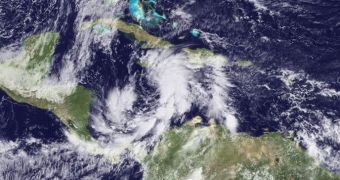Weather experts warn of the looming threat that tropical storm Tomas is posing on the already-battered nation of Haiti. The atmospheric event may trigger massive landslides in areas that have already been destabilized geologically by the January 7.0-magnitude earthquake.
According to current forecasts, it would appear that the storm will drench the island with heavy showers, which will sweep into the ground, and potentially force it downhill, towards populated areas.
The situation is made even worse by historical records. The country has a rich history of massive landslides caused by tropical storm and hurricanes. The vast majority of landslides were actually produced by such events.
In past instances, landslides have killed thousands in Haiti, but the population is now more exposed and at risk than ever before. Millions were left homeless following the massive tremor that stuck earlier this year, killing over 200,000 people.
Even the quake triggered landslides, which caused small tsunamis as they made their way into the Caribbean Sea. The land that did not separate from hillsides was heavily rattled, says David Petley.
He holds an appointment as a geologist at the Durham University in England, where he is the Wilson Professor of Hazard and Risk, Our Amazing Planet reports.
But the bad news don't stop here. If the already-loosened soil mixes with water, it will cause viscous landslides, and not the solid type. This means that the ground will basically flow downstream faster and more relentlessly, and that it will cover more ground before it stops.
The Miami, Florida-based US National Hurricane Center (NHC) estimates that the center of the storm may not pass directly over the country, although that is not certain.
Even if the nation is spared a direct blow, the rains that will be produced by the edges of the storm will cause the same effects on loose soils.
“Haiti will certainly be impacted by torrential rains, particularly in the mountainous areas. Most of the rain will likely occur tonight and into tomorrow morning,” said yesterday Dennis Feltgen, a spokesman for the NHC.
Tomas is also showing signs of increased intensity, and experts estimate that it could very well turn into a Category 1 hurricane by today November 5.
Residents in Haiti will have a difficult time detecting the landslides, because the thunders and heavy rain usually masks the roar of the incoming disaster. This is why so many victims are recorded yearly.
“At night it's even harder, so whether the storm hits in the day or at night makes a big difference for the final outcome,” Petley adds.
“It's really very difficult to predict what's going to happen now, but the risks are substantial. Our experience elsewhere is that lots of rain in areas that have had earthquakes leads to lots of landslides, so that's a reason to be very cautious in this case,” he concludes.

 14 DAY TRIAL //
14 DAY TRIAL //